Chapter 5 Uniform Circular Motion and Gravitation
5.3 Centripetal Force
Summary
- Calculate friction on a car tire moving in a circle
Any force or combination of forces can cause a centripetal or radial acceleration. Just a few examples are the tension in the rope on a tether ball, the force of Earth’s gravity on the Moon, friction between roller skates and a rink floor, a banked roadway’s force on a car, and forces on the tube of a spinning centrifuge.
Any net force causing uniform circular motion is called a centripetal force. The direction of a centripetal force is toward the center of curvature, the same as the direction of centripetal acceleration. According to Newton’s second law of motion, net force is mass times acceleration: net F = ma. For uniform circular motion, the acceleration is the centripetal acceleration— a = ac. Thus, the magnitude of centripetal force Fc is
You may use whichever expression for centripetal force is more convenient. Centripetal force Fc is always perpendicular to the path and pointing to the centre of curvature, because ac is perpendicular to the velocity and pointing to the centre of curvature.
Note that if you solve the first expression for r, you get
This implies that for a given mass and velocity, a large centripetal force causes a small radius of curvature—that is, a tight curve.
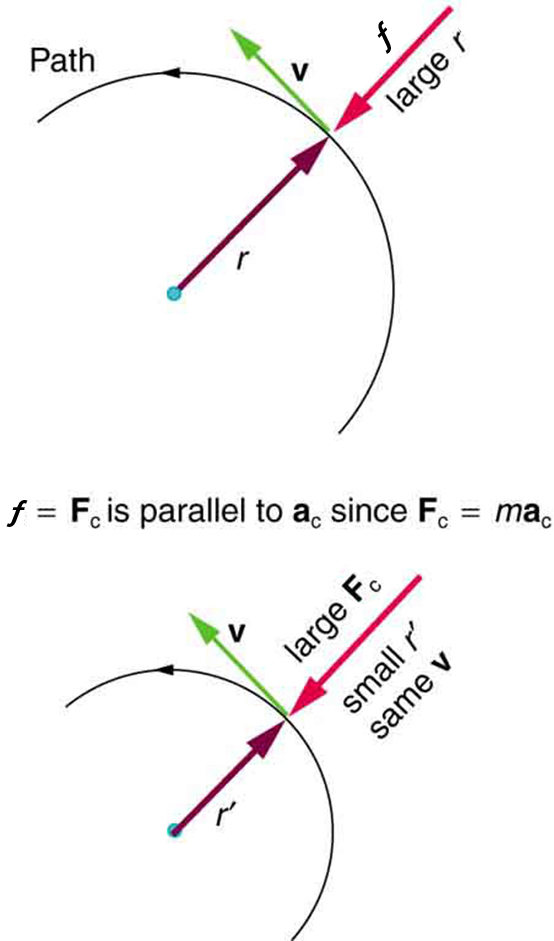
Example 1: What Coefficient of Friction Do Care Tires Need on a Flat Curve?
(a) Calculate the centripetal force exerted on a 900 kg car that negotiates a 500 m radius curve at 25.0 m/s.
(b) Assuming an unbanked curve, find the minimum force of friction , also called traction, due to the tires and the road.
Strategy and Solution for (a)
We know that [latex]\boldsymbol{{F}_{\textbf{c}}=\frac{mv^2}{r}}.[/latex]Thus,
Strategy for (b)
Figure 2 shows the forces acting on the car on an unbanked (level ground) curve. Friction is to the left, keeping the car from slipping, and because it is the only horizontal force acting on the car, the friction is the centripetal force in this case.
We could also solve part (a) using the first expression in [latex]\begin{array}{l} \boldsymbol{F_{\textbf{c}}=m\frac{v^2}{r}} \\ \boldsymbol{F_{\textbf{c}}=mr\omega^2} \end{array}[/latex][latex]\rbrace[/latex], because m, v, and r are given.
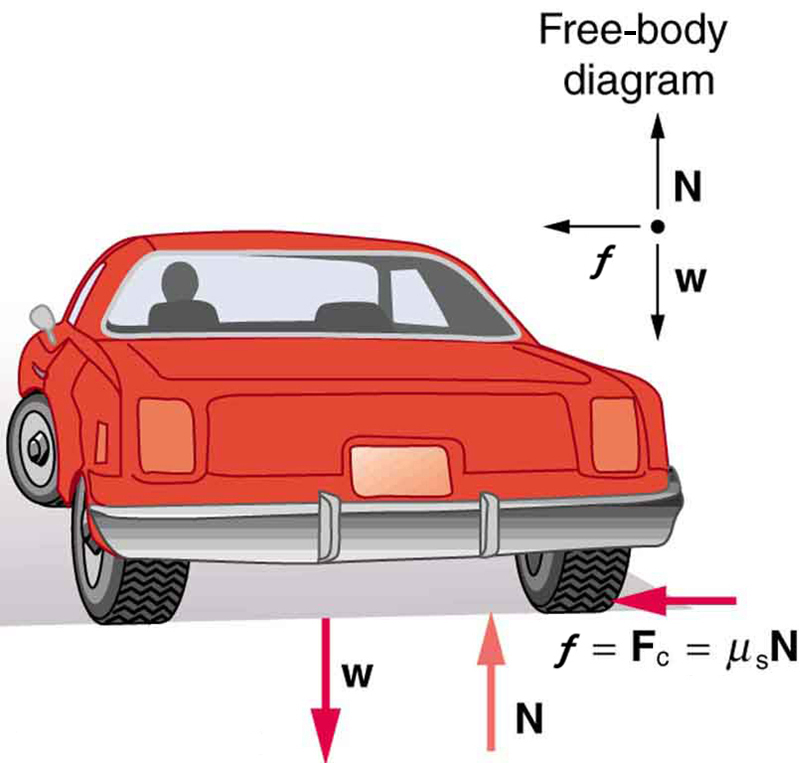
TAKE-HOME EXPERIMENT
Ask a friend or relative to swing a golf club or a tennis racquet. Take appropriate measurements to estimate the centripetal acceleration of the end of the club or racquet. You may choose to do this in slow motion.
PHET EXPLORATIONS: GRAVITY AND ORBITS
Move the sun, earth, moon and space station to see how it affects their gravitational forces and orbital paths. Visualize the sizes and distances between different heavenly bodies, and turn off gravity to see what would happen without it!

Section Summary
- Centripetal force Fc is any force causing uniform circular motion. It is a “centre-seeking” force that always points toward the center of rotation. It is perpendicular to linear velocity v and has magnitude
[latex]\boldsymbol{F_{\textbf{c}}=ma_{\textbf{c}}},[/latex]
which can also be expressed as
[latex]\boldsymbol{F_{\textbf{c}}=m\frac{v^2}{r}}[/latex]
or
[latex]\boldsymbol{F_{\textbf{c}}=mr\omega^2}[/latex]
Conceptual Questions
Conceptual Questions
1: If you wish to reduce the stress (which is related to centripetal force) on high-speed tires, would you use large- or small-diameter tires? Explain.
2: Define centripetal force. Can any type of force (for example, tension, gravitational force, friction, and so on) be a centripetal force? Can any combination of forces be a centripetal force?
3: If centripetal force is directed toward the centre, why do you feel that you are ‘thrown’ away from the centre as a car goes around a curve? Explain.
4: Race car drivers routinely cut corners as shown in Figure 5. Explain how this allows the curve to be taken at the greatest speed.
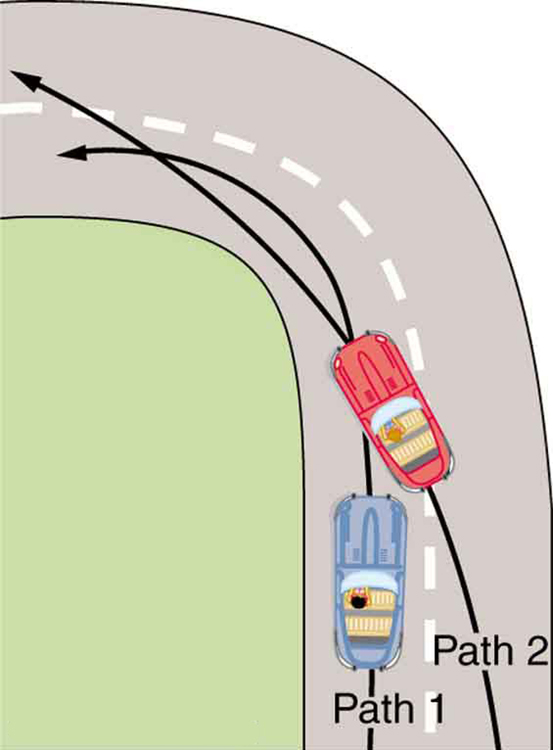
5: A number of amusement parks have rides that make vertical loops like the one shown in Figure 6. For safety, the cars are attached to the rails in such a way that they cannot fall off. If the car goes over the top at just the right speed, gravity alone will supply the centripetal force. What other force acts and what is its direction if:
(a) The car goes over the top at faster than this speed?
(b)The car goes over the top at slower than this speed?
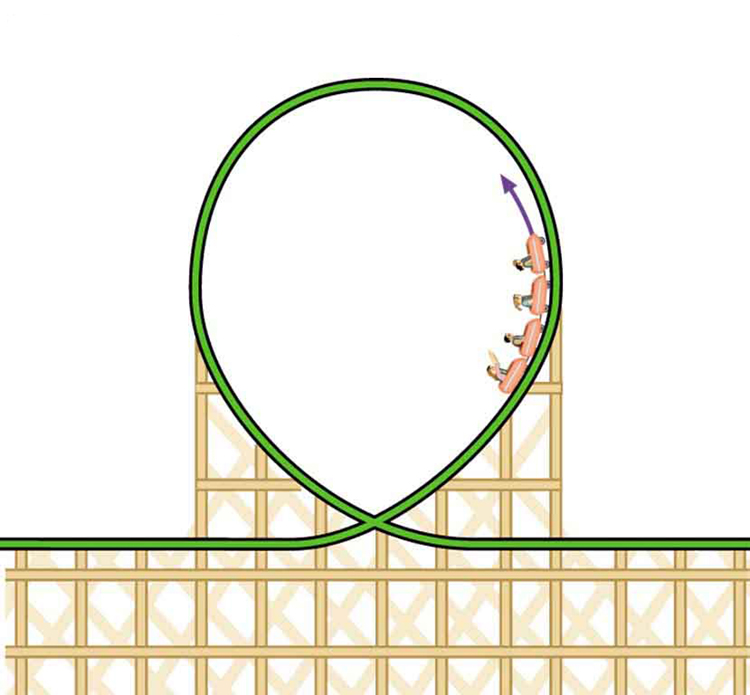
7: What is the direction of the force exerted by the car on the passenger as the car goes over the top of the amusement ride pictured in Figure 6 under the following circumstances:
(a) The car goes over the top at such a speed that the gravitational force is the only force acting?
(b) The car goes over the top faster than this speed?
(c) The car goes over the top slower than this speed?
8: As a skater forms a circle, what force is responsible for making her turn? Use a free body diagram in your answer.
9: Suppose a child is riding on a merry-go-round at a distance about halfway between its centre and edge. She has a lunch box resting on wax paper, so that there is very little friction between it and the merry-go-round. Which path shown in Figure 7 will the lunch box take when she lets go? The lunch box leaves a trail in the dust on the merry-go-round. Is that trail straight, curved to the left, or curved to the right? Explain your answer.
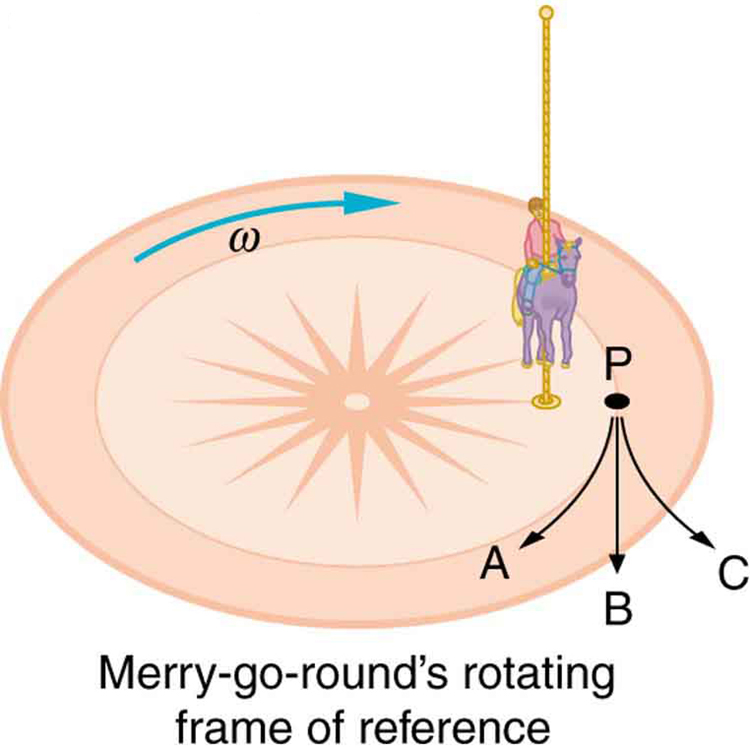
11: Suppose a mass is moving in a circular path on a frictionless table as shown in figure. In the Earth’s frame of reference, there is no centrifugal force pulling the mass away from the centre of rotation, yet there is a very real force stretching the string attaching the mass to the nail. Using concepts related to centripetal force and Newton’s third law, explain what force stretches the string, identifying its physical origin.
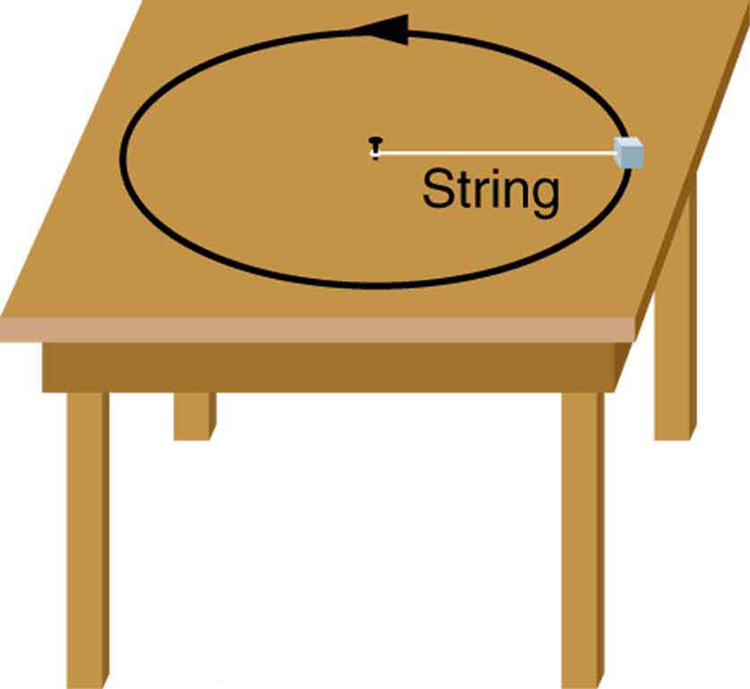
Problems & Exercises
1: (a) A 22.0 kg child is riding a playground merry-go-round that is rotating at 40.0 rev/min. What centripetal force must she exert to stay on if she is 1.25 m from its centre?
(b) What centripetal force does she need to stay on an amusement park merry-go-round that rotates at 3.00 rev/min if she is 8.00 m from its center?
(c) Compare each force with her weight.
2: Calculate the centripetal force on the end of a 100 m (radius) wind turbine blade that is rotating at 0.5 rev/s. Assume the mass is 4 kg.
7: A large centrifuge, like the one shown in Figure 10(a), is used to expose aspiring astronauts to accelerations similar to those experienced in rocket launches and atmospheric reentries.
(a) At what angular velocity is the centripetal acceleration 10 g if the rider is 15.0 m from the centre of rotation?
(b) The rider’s cage hangs on a pivot at the end of the arm, allowing it to swing outward during rotation as shown in Figure 10(b). At what angle θ below the horizontal will the cage hang when the centripetal acceleration is 10 g? (Hint: The arm supplies centripetal force and supports the weight of the cage. Draw a free body diagram of the forces to see what the angle θ should be.)
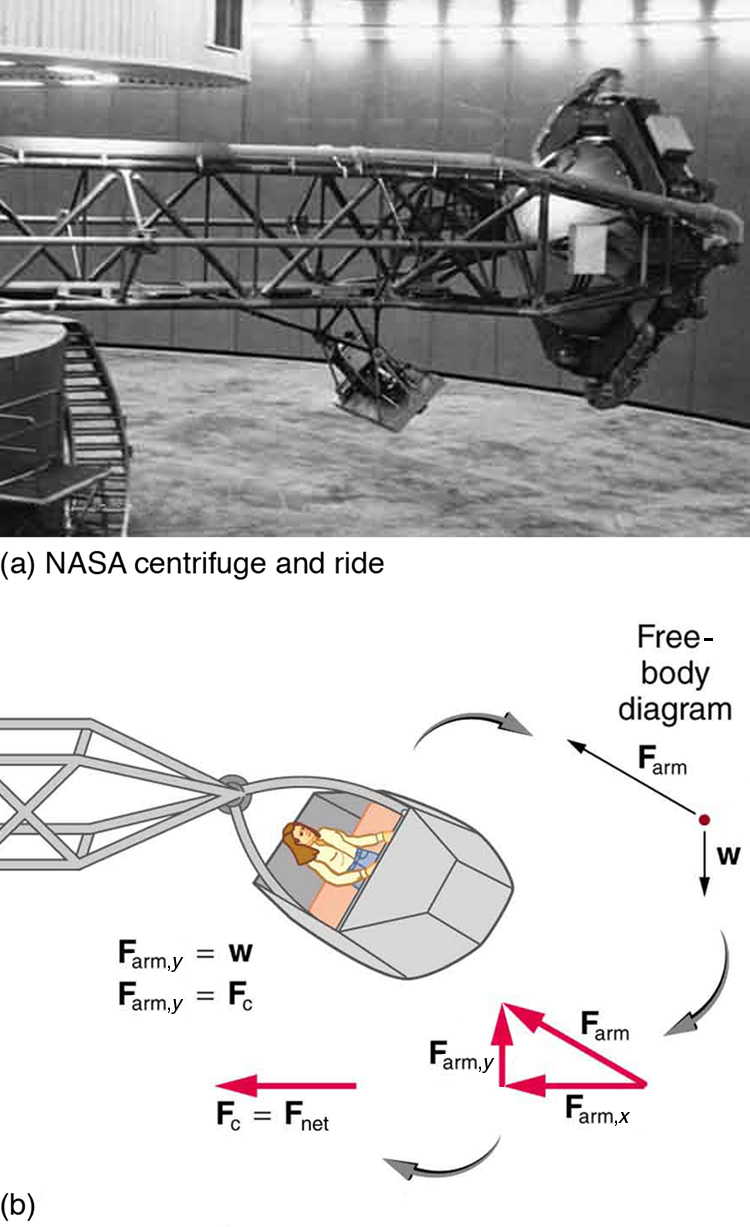
9: Modern roller coasters have vertical loops like the one shown in Figure 11. The radius of curvature is smaller at the top than on the sides so that the downward centripetal acceleration at the top will be greater than the acceleration due to gravity, keeping the passengers pressed firmly into their seats. What is the speed of the roller coaster at the top of the loop if the radius of curvature there is 15.0 m and the downward acceleration of the car is 1.50 g?
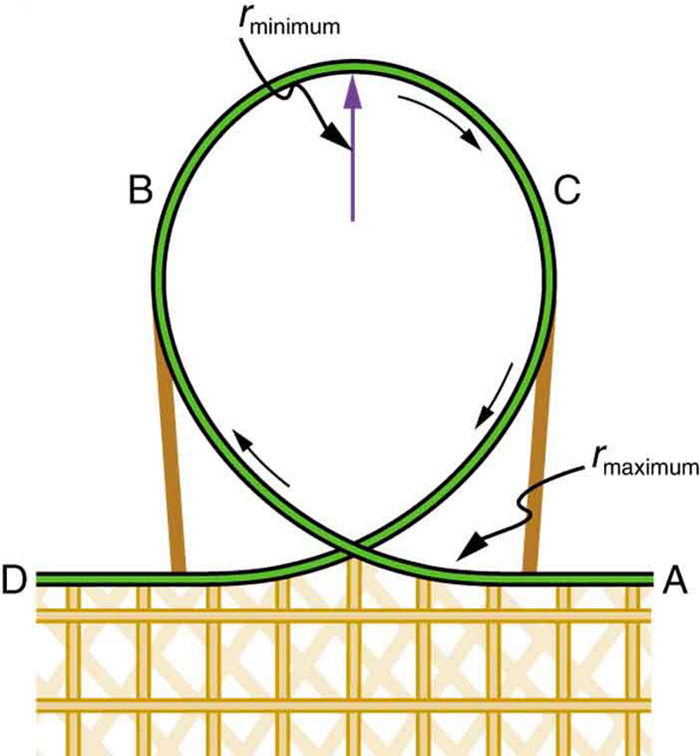
Glossary
- centripetal force
- any net force causing uniform circular motion
- ideal banking
- the sloping of a curve in a road, where the angle of the slope allows the vehicle to negotiate the curve at a certain speed without the aid of friction between the tires and the road; the net external force on the vehicle equals the horizontal centripetal force in the absence of friction
Solutions
Problems & Exercises
1: (a) 483 N b) 17.4 N (c) 2.24 times her weight, 0.0807 times her weight
3: 4.14^
5: (a) $$\boldsymbol{24.6\textbf{ m}}$$ (b) [latex]\boldsymbol{36.6\textbf{ m/s}^2}[/latex] (c) [latex]\boldsymbol{a_{\textbf{c}}=3.73\textbf{ g}.}[/latex]
This does not seem too large, but it is clear that bobsledders feel a lot of force on them going through sharply banked turns.
7: (a) 2.56 rad/s (b) 5.71o

